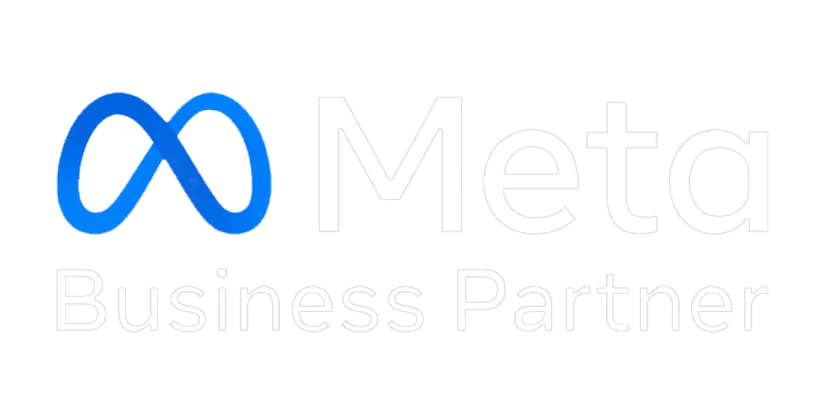How to Segment Your WhatsApp Audience for Smarter Marketing in 2025
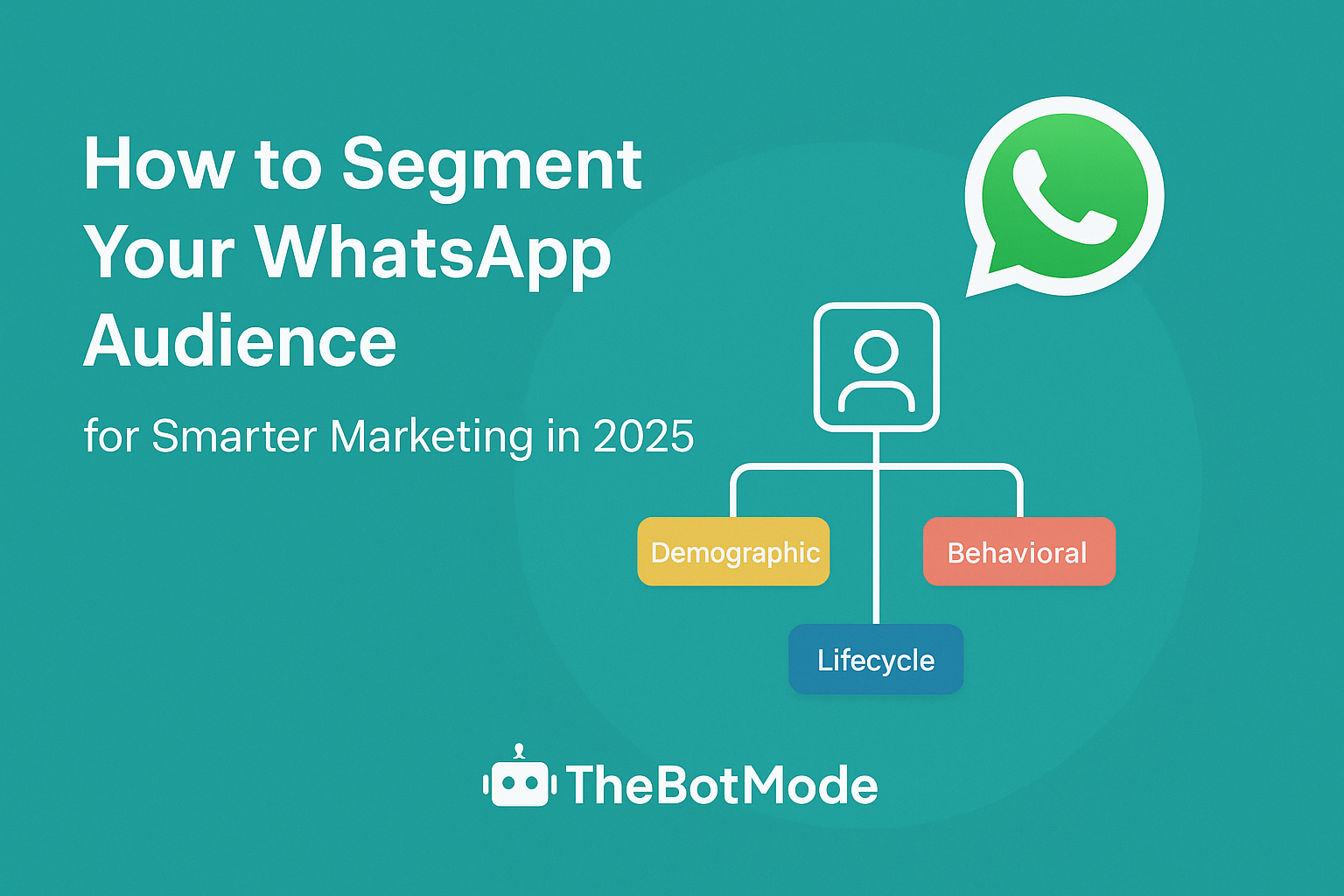
Introduction WhatsApp is no longer just a chat app—it’s one of the most effective channels for businesses to engage, convert, and retain customers. With almost 3 billion monthly active users globally and staggering open rates, WhatsApp messages land where people are already spending their attention. But sending generic mass messages just won’t cut it in 2025. The expectation from users is relevance, timeliness, and value. That’s where segmentation comes in—a strategic way to organize your audience into meaningful groups so you can send smarter messages. At TheBotMode.com, we believe segmentation is the backbone of effective WhatsApp marketing. In this article, you’ll discover how to define segments, set them up using TheBotMode’s tools, and measure their impact to grow traffic, engagement, and ROI. Why Segmenting Your WhatsApp Audience Matters More Than Ever Key WhatsApp Segmentation Types to Use in 2025 Here are the most relevant segmentation types in 2025, especially when backed by tools like TheBotMode: Segment Type What It Means Use Case / How TheBotMode Helps Demographic Age, gender, location, language, job role Use forms/chatbot at the opt‑in stage to collect this info, tag users accordingly for region‑based offers, multilingual campaigns. Geographic Country, city, region, timezone Schedule messages when they’re awake & receptive, run local promotions or events. Behavioral What a user does: clicks, opens, messages, purchases, cart abandonment, etc. Trigger follow‑ups for cart abandoners, reward frequent readers or purchasers. The BotMode can track behaviors via flows & tags. Lifecycle / Funnel Stage Where a user is: lead, new customer, repeat customer, inactive, churned Different nurture flows: onboarding for new, loyalty or VIP offers for repeat, and win‑back for inactive. Value‑Based High customer lifetime value vs casual buyer; order size; frequency Prioritize high‑value segment for exclusive offers, early access, VIP content. Interest‑Based / Psychographic Interests, attitudes, preferences, product types Use polls, chat responses to build interest tags; tailor content accordingly. How to Set Up Segmentation with TheBotMode Here’s a step‑by‑step guide to using segmentation features effectively with TheBotMode.com: Real‑World WhatsApp Segmentation Use Cases Here are examples of segments and what you can do with them: Common Segmentation Mistakes to Avoid Tracking Success & Improving Results How TheBotMode Supercharges WhatsApp Segmentation Here’s how TheBotMode.com makes segmentation practical, actionable, and powerful: Want to try this in action? You can start with one segment today (say, cart abandoners or new leads), use TheBotMode’s tagging and flow builder, and send a simple targeted broadcast. You’ll often see uplift even with small changes. Conclusion Segmentation isn’t optional—it’s essential in 2025 if you want WhatsApp marketing that’s relevant, efficient, and high‑performing. When you segment wisely, you improve engagement, boost conversions, reduce unsubscribes, and make better use of your time and budget. At TheBotMode.com, you have the tools you need to define meaningful segments, build dynamic flows, and analyze what works. Your next step? Pick one segment (new leads, inactive users, or VIPs), design a targeted message flow, test it, measure results—and iterate. Call to Action: Head over to TheBotMode.com, explore our segmentation features, and launch your first smart WhatsApp campaign today. FAQs Q: What’s the best way to segment WhatsApp contacts in 2025? A: Start with lifecycle or behavior‑based segments (new leads, inactive users, high‑value customers) using tags, followed by interest and demographic segmentation once you have enough data. Q: How can I personalize messages in WhatsApp marketing without being intrusive? A: Use snippets like name, past purchase, or preferences. Offer value (help, tips, offers) rather than just promotions. Respect timing & frequency. Always give the opt‑out. Q: Can small businesses benefit from segmentation, or is it only for large enterprises? A: Yes—small businesses gain big from even simple segmentation. Even creating just 2‑3 segments (e.g., new vs. returning customers) can boost engagement and ROI. Q: Is segmentation possible if I’m using WhatsApp Business (app) vs. API? A: Yes—while the API gives more automation & integration capacities, you can still use tags and segment manually via the Business App or TheBotMode’s tools. Many segmentation workflows don’t need the full API. Q: How often should I update or refresh my segments? A: Behavior or engagement-based segments—weekly (or even real‑time if possible); lifecycle/funnel segments—monthly or when data from CRM triggers a shift. Always review performance and adapt.
How D2C Brands Can Recover More Revenue with Abandoned Cart Strategies
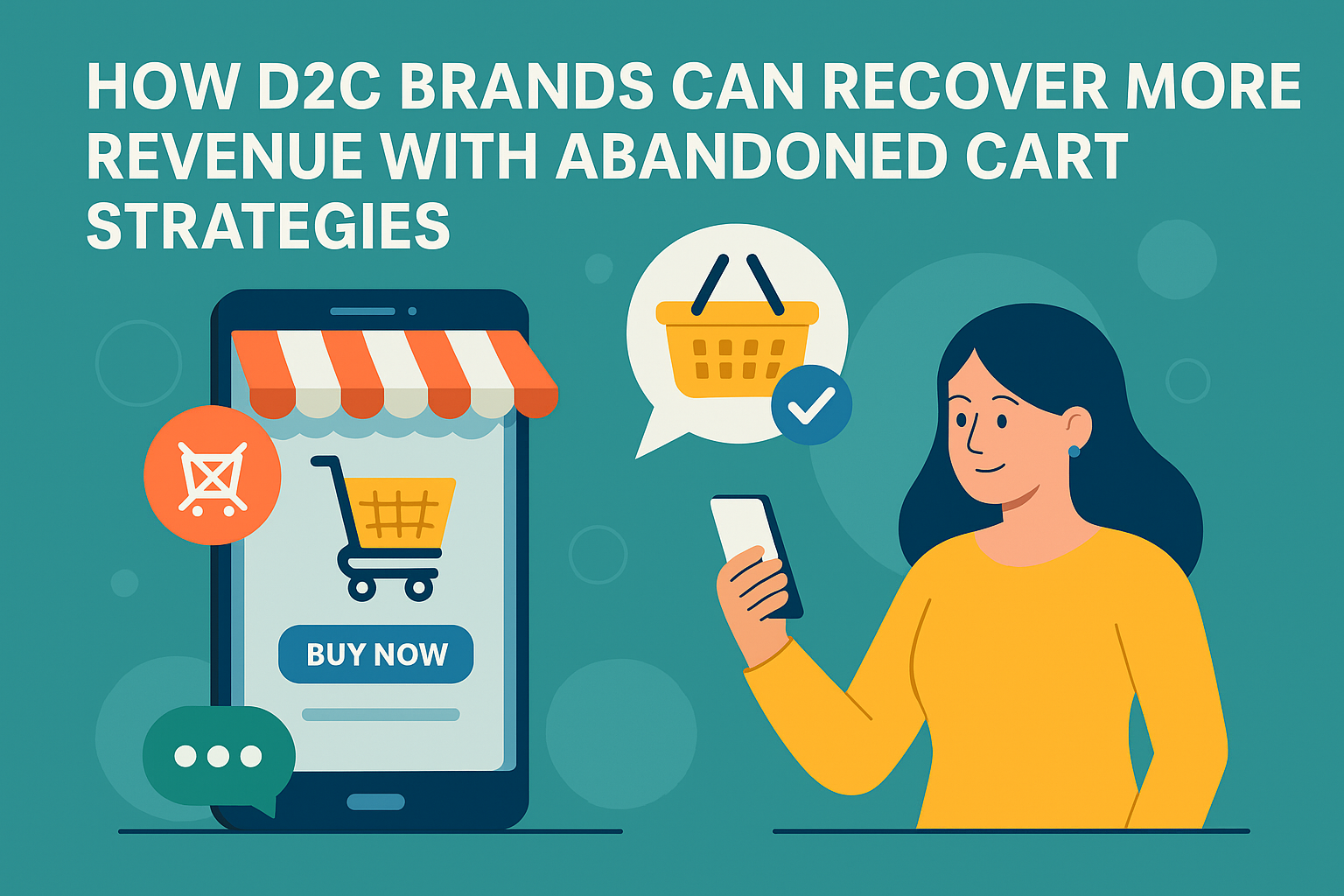
Why Abandoned Cart Recovery Is Mission-Critical for D2C Brands In today’s competitive D2C landscape, every cart left behind is a missed opportunity—and they’re happening a lot. Studies show nearly 7 out of 10 online shopping carts are abandoned, often before customers even begin the checkout process. For D2C brands, this represents millions in lost revenue, wasted ad spend, and a significant drop in customer lifetime value. But here’s the good news: a strong abandoned cart recovery strategy can turn those losses into reliable revenue. And the best part? You don’t need to rely solely on email anymore. Tools like WhatsApp Business, the WhatsApp Business API, and smart message automation are rewriting the rules of cart recovery. Why Are Customers Abandoning Carts? Before you solve the problem, you need to understand it. The most common reasons for cart abandonment include: While these issues can’t be eliminated entirely, timely and personalized outreach can help pull customers back in—and WhatsApp is one of the best platforms to do it. Why WhatsApp Is a Game-Changer for Cart Recovery 1. Instant Visibility and Engagement Traditional email reminders often get ignored or filtered. In contrast, WhatsApp messages have a 98% open rate—and are usually read within the first 5 minutes. That immediacy creates a powerful opportunity for recovery. 2. WhatsApp Business vs WhatsApp Business API 3. Build Trust Through Humanized Automation With the WhatsApp chatbot, you can answer real-time queries, ease purchasing anxiety, and recover sales 24/7—without lifting a finger. It’s automation that feels human. Key Components of a Winning WhatsApp Cart Recovery Strategy Perfect Your Timing Timing is everything. Your recovery flow should include: Segment for Precision One-size-fits-all messaging won’t cut it. Segment customers based on: Then tailor your whatsapp message marketing strategy accordingly. Message Content That Converts What makes an effective cart recovery message? 👉 Abandoned Cart Recovery FAQs (Optimized for Voice Search & Featured Snippets) Q1: What is WhatsApp Business used for in eCommerce? WhatsApp Business helps brands automate customer engagement, support, and cart recovery—leading to higher conversions. Q2: Is the WhatsApp Business API necessary for abandoned cart automation? Yes. The API enables scalable automation, chatbot integration, and customized cart recovery messaging. Q3: Do WhatsApp chatbots really work for recovering abandoned carts? Absolutely. They handle objections, provide support, and close sales—24/7, instantly. Q4: How effective is WhatsApp compared to email for cart recovery? WhatsApp outperforms email with open rates of 98% and click-through rates over 35%, making it ideal for recovery. Q5: Can I use WhatsApp marketing without spamming customers? Yes. As long as you use opt-in and approved templates, WhatsApp marketing remains non-intrusive and valuable.
How to Verify Your WhatsApp Business Account
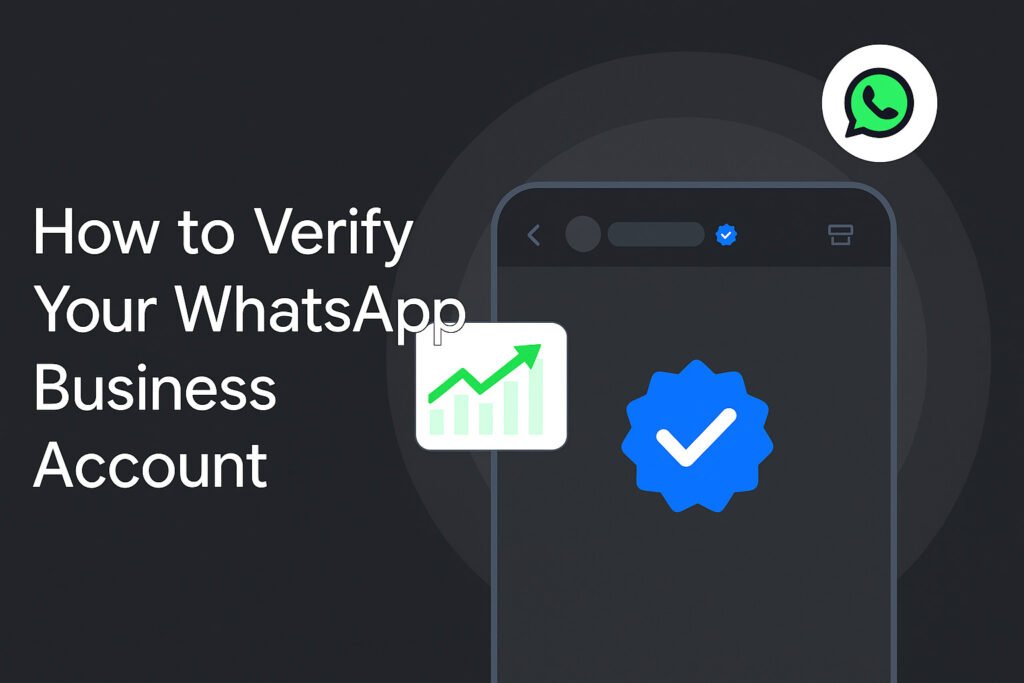
Introduction For businesses worldwide, WhatsApp Business has become a key tool to connect with customers directly, share updates, and build trust. But simply setting up a WhatsApp Business account is not enough. To unlock advanced features like the green tick verification badge, higher trust levels, and full WhatsApp Business API access, you need to verify your WhatsApp Business Account. In this guide, we’ll explain step by step how to verify your WhatsApp Business Account, why it matters, and how local businesses across regions can benefit. Why WhatsApp Business Verification is Important Step-by-Step Guide to Verify Your WhatsApp Business Account 1. Set Up a Meta Business Manager Account 2. Add Your Business Details 3. Verify Your Business in Meta Business Manager 4. Connect Your WhatsApp Business Account 5. Request WhatsApp Business Verification 6. Await Approval Specific Notes Tip: Always ensure your submitted business name matches exactly with your supporting documents. Common Reasons for Rejection FAQs Q1. Do I need a green tick to use WhatsApp Business API? No. You can use the API without the green tick, but the tick improves brand trust. Q2. How long does verification take? Typically 3–7 business days for Meta verification, plus 1–2 weeks for WhatsApp verification. Q3. Can small businesses also get verified? Yes, but ensure you have a professional website and proper documents. Q4. What if my request is rejected? You can reapply after 30 days with corrected or updated documents. Conclusion Verifying your WhatsApp Business Account is a must if you want to build customer trust, unlock advanced messaging features, and scale your business globally. By following the steps above and preparing the right documents based on your country, you can complete the process smoothly and increase your brand’s credibility. If you are a D2C brand, startup, or local business looking to automate and grow with WhatsApp, consider setting up your verification early.
Unlocking Growth: WhatsApp Marketing Strategies for D2C Brands
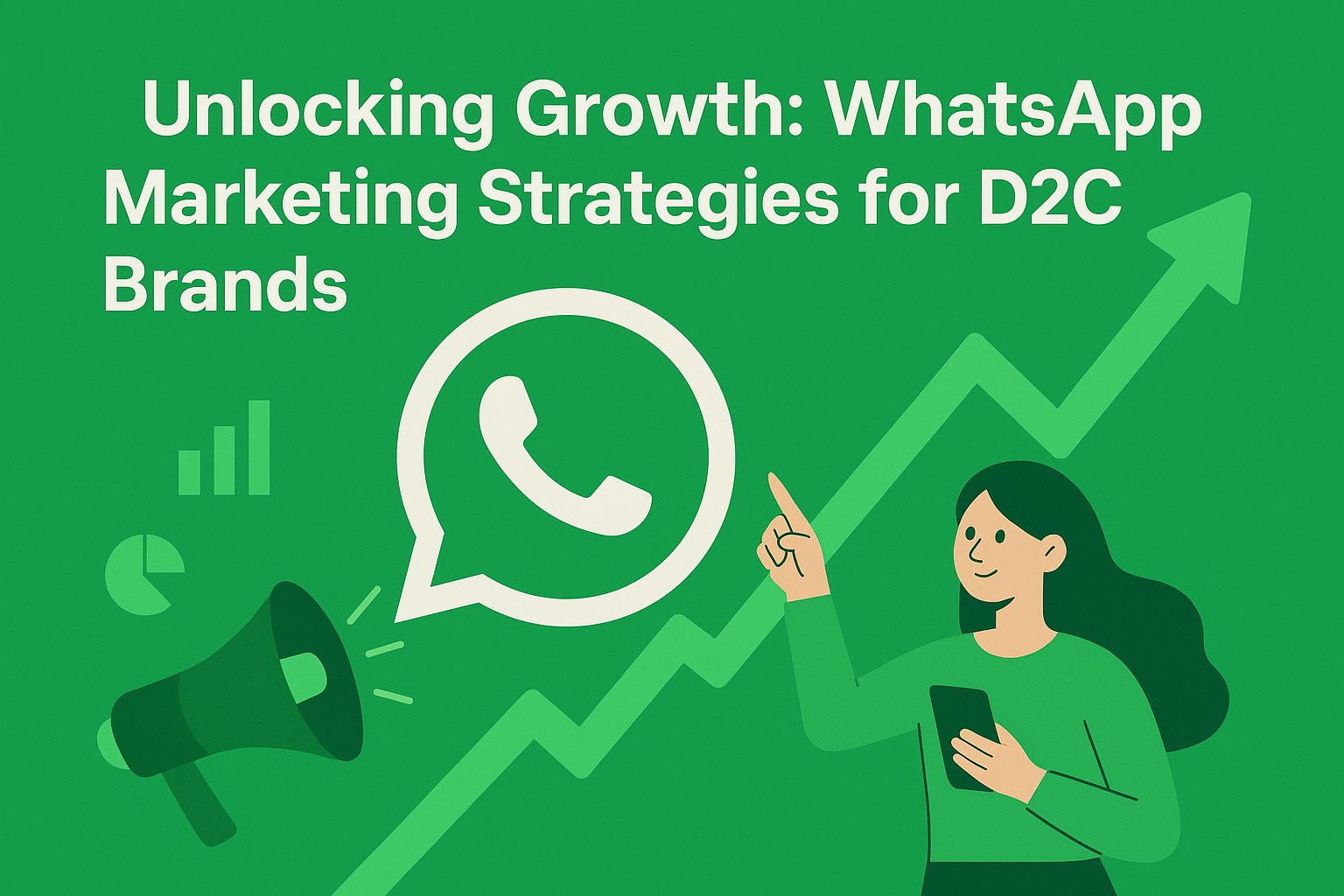
Introduction D2C (Direct-to-Consumer) brands are redefining the retail landscape by eliminating middlemen and connecting directly with consumers. But with great access comes intense competition. To stand out, brands must embrace highly personalized, real-time communication. That’s where WhatsApp marketing becomes a game-changer. With over 2 billion users globally and open rates exceeding 98%, WhatsApp offers D2C brands a direct line to customers’ hearts—and wallets. In this blog, we explore effective strategies using WhatsApp Business, WhatsApp Business API, chatbots, and message marketing to drive traffic, increase conversions, and build loyalty. What Makes WhatsApp a Powerful Tool for D2C Brands WhatsApp Business & WhatsApp Business API: Understanding the Difference Pro Tip: If you’re scaling operations or managing hundreds of orders and support queries daily, upgrade to the API to streamline everything. Key Statistics that Prove WhatsApp Marketing Works Core WhatsApp Marketing Strategies for D2C Brands Personalization via Chat and Conversational Selling Using a WhatsApp chatbot, you can instantly assist users with product queries, offer suggestions, or even walk them through checkout—all while maintaining a human-like interaction. Combine this with customer segmentation to tailor messages based on behavior, purchase history, or preferences. Automated Messages & Notifications (Using WhatsApp Business API) Send real-time order updates, shipping alerts, and abandoned cart reminders using API-approved message templates. Automating these messages boosts engagement and reduces customer support load. Drip Campaigns, Broadcasts & Segmented Message Marketing Broadcast promotional messages or run drip campaigns to specific customer segments: Chatbots: 24/7 Support at Scale Automate responses to FAQs, product inquiries, and return policies using AI-powered chatbots. Enable human handoff for complex issues to maintain a seamless support experience. Integrations: CRM, E-commerce, Analytics Integrate WhatsApp API with platforms like Shopify, WooCommerce, and your CRM to: Conclusion For D2C brands looking to grow in 2025 and beyond, WhatsApp marketing isn’t just an option—it’s a necessity. With the right strategy and tools, you can enhance customer experience, reduce cart abandonment, and turn casual browsers into loyal buyers. Start small—send order updates or a welcome series—then scale with chatbots, API automation, and targeted campaigns. When done right, WhatsApp becomes your most personal and powerful marketing channel. 👉 Explore your options with TheBotMode and take your first step toward smarter customer conversations. FAQs Q 1. What is WhatsApp Business API and how is it different from the regular app? The API is built for scale—it offers bulk messaging, chatbot integration, and analytics. The regular app is more manual and suited for small teams. Q 2. How can a chatbot help my D2C brand on WhatsApp? A chatbot provides 24/7 support, handles repetitive queries, recommends products, and improves conversion through guided shopping. Q 3.What metrics should I track for WhatsApp marketing? Focus on open rates, response time, conversion rate, average order value, and repeat purchase rate. Q 4. How many marketing messages can I send without annoying customers? Stick to 1-3 high-value messages per week. Prioritize relevance and timing to avoid opt-outs. Q 5. What are the legal requirements for sending WhatsApp marketing messages in India? You must obtain clear user consent (opt-in), avoid misleading content, and comply with data protection laws like the IT Act and WhatsApp’s Commerce Policy.
Boost WhatsApp Conversions for D2C Brands Using The BotMode
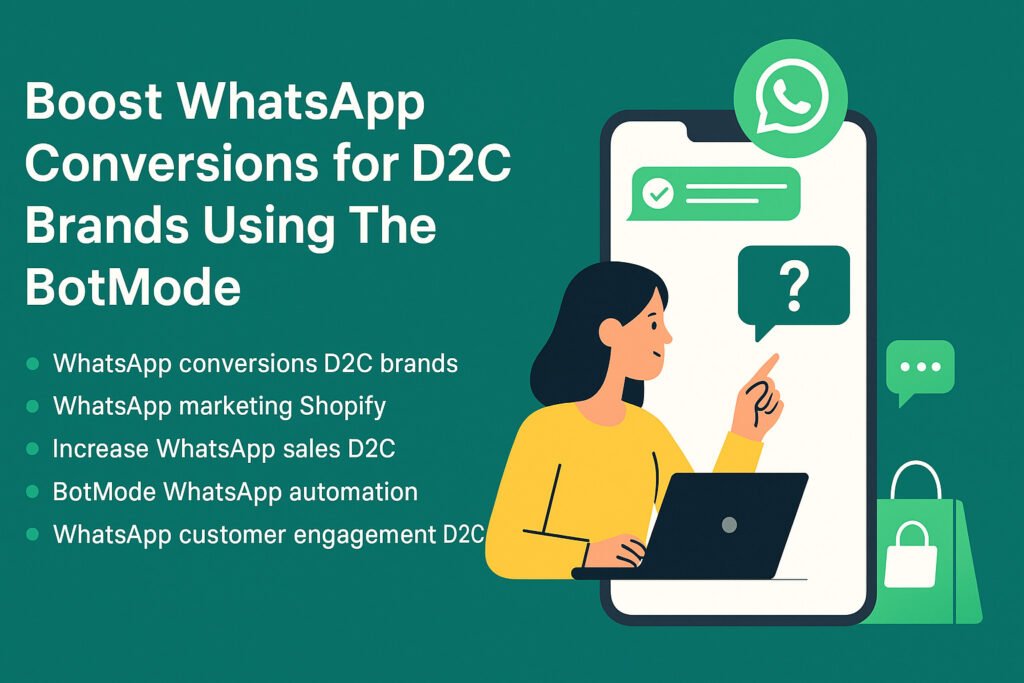
Introduction Direct-to-consumer (D2C) brands face fierce competition in eCommerce. With channels like email and social ads becoming saturated, WhatsApp offers a unique, highly personal way to engage customers. At The BotMode, we help Shopify and other D2C brands unlock powerful WhatsApp conversion strategies using smart automation, personalization, and seamless shopping experiences. Why WhatsApp Works for D2C Brands Key Strategies to Boost WhatsApp Conversions with The BotMode 1. Seamless Opt-in Experience on Your Store Place clear WhatsApp opt-in prompts on key pages like product pages, cart, and checkout. Offer value—such as early access, tracking updates, or exclusive offers—to motivate customers to subscribe to WhatsApp updates. 2. Automate Welcome and Abandoned Cart Messages Use The BotMode to trigger a friendly WhatsApp message when customers subscribe or abandon carts. Include product images, direct links, and a gentle nudge to complete their purchase. 3. Use Interactive Product Recommendations Leverage BotMode’s AI to analyze browsing or purchase history and suggest relevant products via WhatsApp. Interactive messages that ask a question like “Interested in complimentary products for your skincare purchase” can nudge conversions. 4. Send Order Confirmations and Tracking Updates Automate order confirmation, shipping and delivery notifications via WhatsApp. This improves transparency and builds trust without manual effort from your team. 5. Run Flash Sales or One-Time Offers Announce flash sales, limited-time deals, or product launches via WhatsApp broadcasts. Use urgency and exclusivity to drive quick responses and conversions. 6. Provide Instant Customer Support Enable a hybrid BotMode check-in where common FAQs are handled by bots, but escalations are quickly passed to humans. This hybrid approach ensures fast resolutions and helps drive sales. 7. Collect Post-Purchase Reviews and Feedback After delivery, send WhatsApp requests for reviews or feedback. Positive feedback can be directed to your site to boost social proof and repeat purchases. 8. Use Analytics to Refine Strategy Monitor open rates, click-throughs, and conversion rates from WhatsApp campaigns. BotMode analytics help you refine message timing, content, and frequency for optimal results. Real Results D2C Brands Have Seen FAQs What is The BotMode and how does it help with WhatsApp conversions? The BotMode is a WhatsApp automation and engagement platform designed for D2C brands. It helps automate messages like cart reminders, product recommendations, and order updates in a personalized, scalable way. Is WhatsApp marketing GDPR compliant? Yes. The BotMode ensures all WhatsApp communication adheres to GDPR, including collecting explicit opt-ins, providing easy opt-outs, and respecting user privacy. How do I collect WhatsApp opt-ins on my Shopify store? You can use The BotMode widget or banners on product, cart, and checkout pages offering something of value—like special discounts or updates—to encourage customers to subscribe. Can WhatsApp messages integrate with other marketing tools? Yes. The BotMode integrates with Shopify, CRMs, email tools, and analytics platforms so you can maintain a unified marketing view and automate across touch points. What kind of ROI can D2C brands expect? Results vary by brand, but popular outcomes include higher open and conversion rates, faster support responses, more recovered carts, and greater average order value from targeted upsells. Conclusion For D2C brands aiming to stand out in a crowded eCommerce landscape, WhatsApp offers an unparalleled channel for engagement and conversion. With The BotMode, you can automate, personalize, and scale powerful WhatsApp marketing that drives results.Start boosting your conversions today with smarter WhatsApp strategies for your Shopify store. Let me know if you’d like adjustments, specific examples, or coverage of other aspects like growth strategies or integration details.
D2C Brands: Switch COD Orders to Prepaid with WhatsApp

Introduction For most D2C brands in India and emerging markets, Cash on Delivery (COD) is still a dominant payment method. While it offers flexibility to customers, COD often turns into a liability for businesses due to high Return-to-Origin (RTO) rates, fake orders, and delayed cash flow. On the other hand, prepaid orders ensure faster payments, reduced operational costs, and better forecasting. The good news? D2C brands can now use WhatsApp Marketing and WhatsApp marketing automation to seamlessly shift COD orders to prepaid — without harming customer experience. The Challenges of COD for D2C Brands Why Prepaid Orders Are Better How WhatsApp Marketing Automation Converts COD to Prepaid WhatsApp has become the go-to platform for D2C engagement. With WhatsApp marketing automation, brands can create smart flows that nudge COD buyers to switch to prepaid instantly. Key Automation Tactics Case Studies: COD to Prepaid Success Metrics to Track Conclusion Shifting from COD to prepaid isn’t just about reducing losses — it’s about unlocking higher efficiency, better customer loyalty, and stronger cash flow. With WhatsApp marketing automation, D2C brands have a powerful tool to nudge customers naturally and at scale. The key is to experiment, measure results, and refine flows. Even a 10–20% increase in prepaid orders can dramatically improve margins and growth. FAQs: Converting COD Orders to Prepaid with WhatsApp Q1. Why should D2C brands move from COD to prepaid orders? Prepaid orders reduce RTOs, improve cash flow, and lower logistics costs. COD creates higher risks of cancellations, fake orders, and operational inefficiencies. Q2. How can WhatsApp marketing automation help convert COD orders to prepaid? WhatsApp automation sends instant COD confirmation messages, offers incentives, and provides direct payment links. This nudges customers to switch to prepaid seamlessly. Q3. What kind of incentives work best for COD to prepaid conversions? Popular incentives include small discounts (₹50–₹100), free shipping, cashback, or loyalty points. The goal is to make prepaid feel more rewarding than COD. Q4. Can WhatsApp be used for COD order verification? Yes. Brands can set up automated WhatsApp flows to confirm COD orders before dispatch, reducing fake or high-risk orders and lowering RTO rates. Q5. Do customers trust prepaid more than COD? When combined with transparent policies (easy refunds, faster delivery, payment security), prepaid often builds stronger trust. Customers appreciate the convenience and assurance. Q6. How much can WhatsApp automation increase prepaid conversions? Case studies show that D2C brands using WhatsApp COD → prepaid flows see a 15–30% boost in prepaid orders, depending on incentives and messaging strategy. Q7. Should D2C brands completely remove COD? Not immediately. COD is still preferred in some regions. Instead, brands should gradually incentivize prepaid while using WhatsApp automation to reduce reliance on COD.
Why Every D2C Brand Needs a Chatbot for WhatsApp in 2025
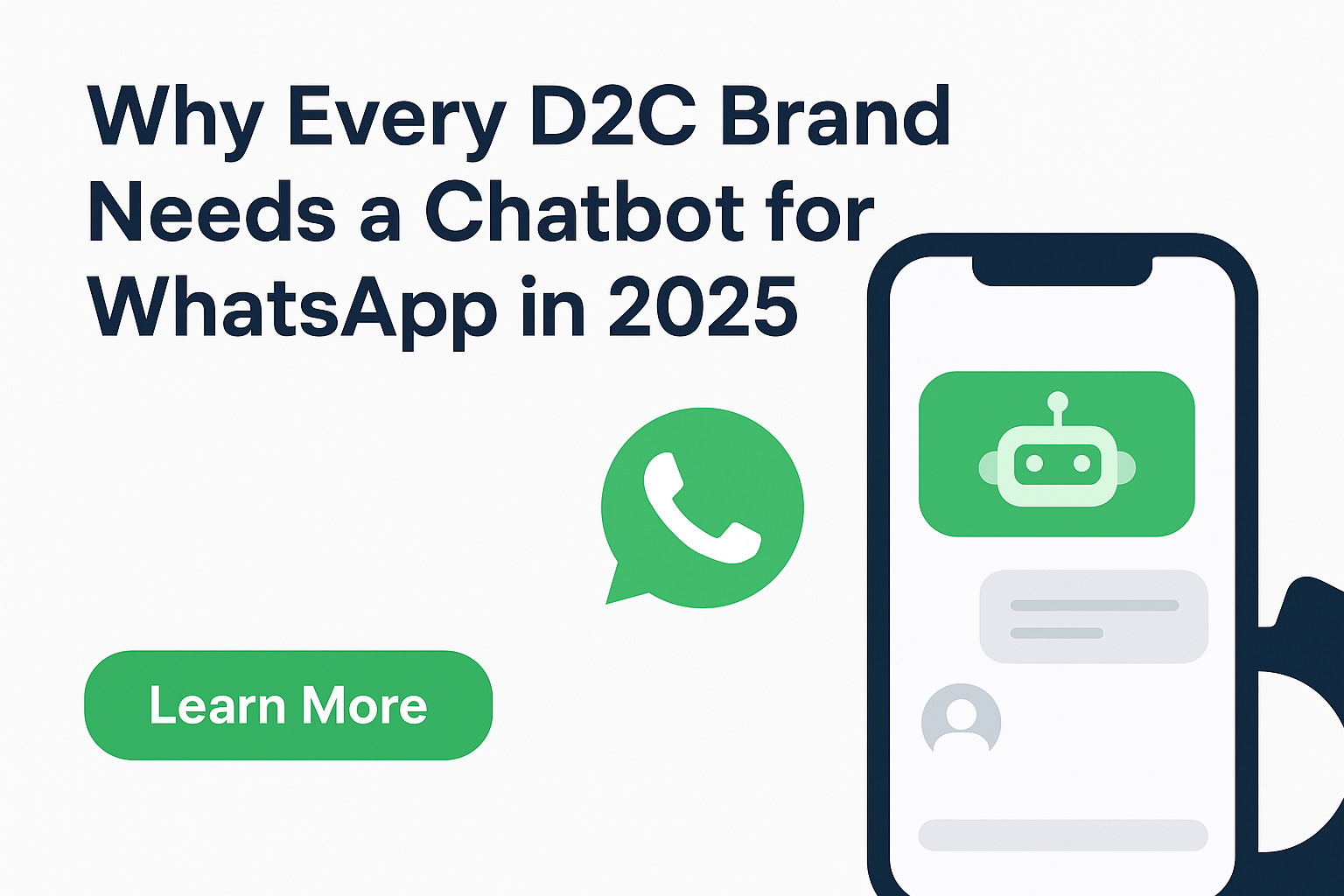
Introduction In the fast-moving world of direct-to-consumer (D2C) brands, customer expectations have never been higher. Shoppers expect rapid responses, seamless checkout, and personalized service—all the time. Enter the WhatsApp chatbot: a tool that delivers real-time engagement, automates routine tasks, and scales your support and sales channels. In 2025, having a strong chatbot for WhatsApp is no longer a luxury—it’s a necessity. This post explores why every D2C brand should adopt a WhatsApp chatbot this year, the benefits, best practices, and how to get started. What Is a WhatsApp Chatbot A WhatsApp chatbot is an automated messaging solution integrated with WhatsApp (often via the WhatsApp Business API) that can respond to customers, guide them through workflows, share product catalogs, process certain requests, and even facilitate purchases. Unlike manual support, where human agents must respond each time, the chatbot can handle routine interactions, FAQs, order updates, abandoned cart reminders, etc., freeing human time for higher-complexity or high-value tasks. Best Practices for D2C Brands Using WhatsApp Chatbots Challenges & Things to Watch Out How to Get Started with a WhatsApp Chatbot for Your D2C Brand Also, check out this detailed look at WhatsApp chatbot message automation to deepen your strategy: WhatsApp chatbot message automation FAQs About WhatsApp Chatbots for D2C Brands Q1. What is a WhatsApp chatbot? A WhatsApp chatbot is an automated conversational tool that interacts with customers on WhatsApp, answering queries, providing updates, and facilitating sales without human intervention. Q2. Why do D2C brands need a chatbot for WhatsApp in 2025? Because consumers demand instant, personalized service. WhatsApp chatbots boost customer satisfaction, reduce costs, and increase conversions—making them essential for D2C success in 2025. Q3. Can a WhatsApp chatbot handle complex customer queries? Yes, but for very complex or emotional issues, a hybrid approach is best: the chatbot handles routine tasks and escalates complex cases to human agents. Q4. Do I need coding skills to set up a WhatsApp chatbot? No. Many platforms allow drag-and-drop chatbot building without coding. Providers like TheBotMode help D2C brands get started quickly. Q5. How much does a WhatsApp chatbot cost? Costs depend on your provider, usage, and message volume. Small brands may start at a low monthly fee, while enterprise plans scale with advanced automation. Q6. Can WhatsApp chatbots help increase sales? Yes. They recover abandoned carts, upsell related products, and personalize offers, often doubling conversion rates compared to traditional channels. Q7. Is a WhatsApp chatbot compliant with WhatsApp rules? Yes—if built via official Business API providers and using approved templates for proactive messages. Compliance ensures uninterrupted service. Conclusion In 2025, a WhatsApp chatbot is more than just an add-on—it’s a core part of what makes D2C brands competitive. From boosting conversions and reducing costs to delivering the kind of customer experience shoppers increasingly expect, there are many compelling reasons to act now.
Why WhatsApp Broadcast Bulk Message Is a Game Changer for D2C Brands
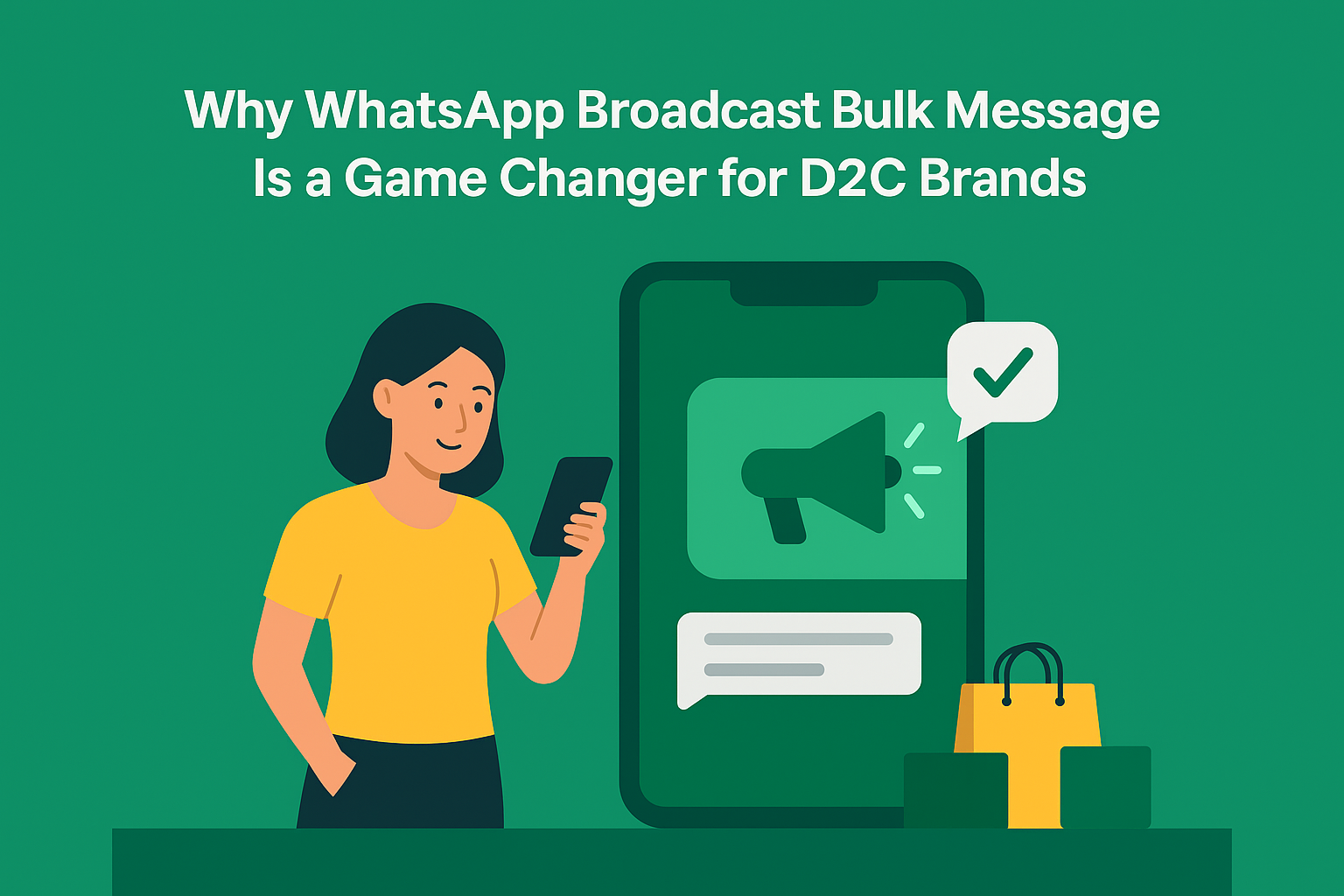
Introduction Direct-to-Consumer (D2C) brands thrive on customer relationships. But with email open rates hovering around 20% and SMS engagement gradually declining, many brands struggle to capture their audience’s attention. Enter WhatsApp broadcast bulk messaging — a tool that combines speed, personalization, and direct engagement. Whether it’s sending WhatsApp broadcast messages for promotions or using broadcast for business to automate updates, the platform has become a must-have for modern D2C marketers. In this blog, we’ll explore why bulk messaging is a game-changer, the benefits for D2C brands, and how to implement it effectively. What Is WhatsApp Broadcast & Bulk Message for Business? A WhatsApp broadcast allows businesses to send one message to multiple recipients at once. Unlike groups, recipients don’t see each other’s replies. For D2C brands, the real power lies in the WhatsApp Business API, which enables bulk messaging at scale with features like: 👉 Learn more in this guide: WhatsApp Broadcast Major Benefits of WhatsApp Broadcast Bulk Message for D2C Brands 1. High Open Rates & Faster Engagement WhatsApp messages enjoy 90%+ open rates, significantly outperforming email and SMS. For D2C brands, that means faster clicks on promotions and immediate responses from customers. 2. Personalization & Segmentation Unlike traditional broadcast tools, WhatsApp allows tailored communication: 3. Abandoned Cart Recovery D2C brands lose millions to abandoned carts. A simple WhatsApp reminder with a product image or discount code often converts better than an email. 4. Cost & Time Efficiency Compared to ad spend on social platforms, bulk WhatsApp broadcasts are affordable. Automation reduces manual work, saving both money and time. 5. Better Customer Experience & Trust Verified business accounts build credibility. Customers feel safe receiving updates like: 6. Improved Loyalty & Repeat Purchases By sending exclusive offers, early access sales, and personalized content, brands can keep customers engaged and drive repeat purchases. Conclusion For D2C brands, WhatsApp broadcast messages aren’t just another channel — they’re a direct bridge to customers’ most active platform. By leveraging WhatsApp broadcast bulk messages strategically — with segmentation, personalization, and automation — brands can boost engagement, recover lost revenue, and build stronger relationships. In 2025 and beyond, WhatsApp broadcast for business will continue to be a growth driver for D2C brands ready to meet customers where they are. FAQs Q1. What’s the difference between WhatsApp broadcast and WhatsApp group? Broadcasts send one-to-many messages privately, while groups let members interact with each other. Q2. Can I send broadcasts to users who haven’t saved my number? Yes, but only via the WhatsApp Business API. Standard broadcast lists require saved contacts. Q3. How many messages can I send daily? It depends on your WhatsApp Business tier. With API, you can scale to thousands per day. Q4. What content works best in broadcasts? Promotions, abandoned cart reminders, delivery updates, and personalized recommendations. Q5. Do I need WhatsApp Business API for bulk messaging? Yes, if you want to scale campaigns and avoid number-saving limitations.
Leveraging WhatsApp for Customer Support: A Complete Guide
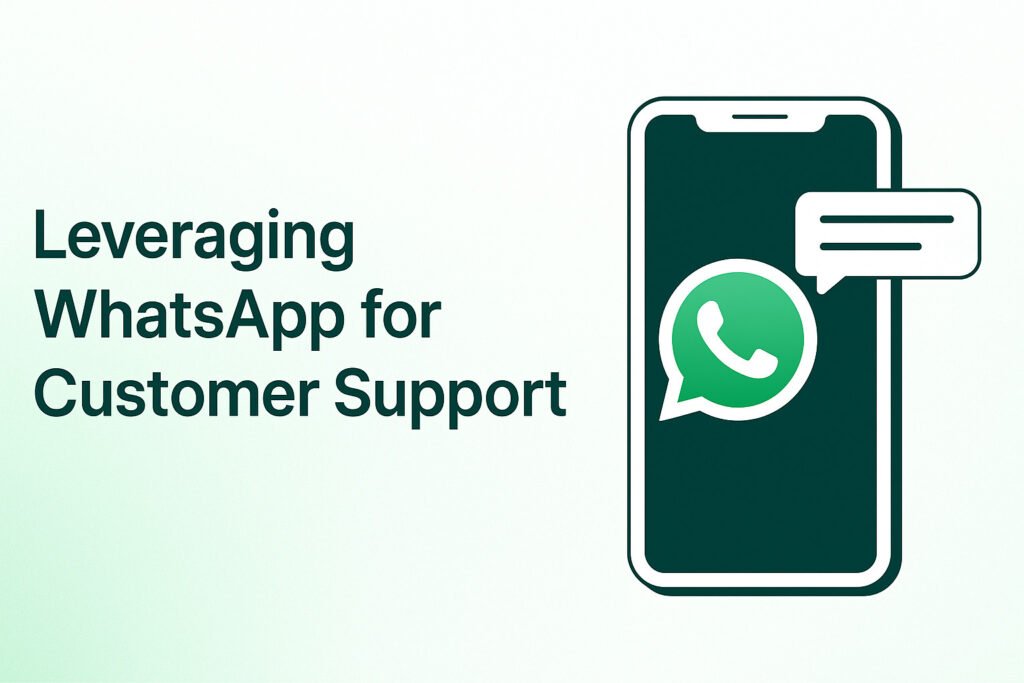
Introduction In today’s digital era, customer expectations are higher than ever. They demand instant, seamless, and personalized support delivered through the platforms they already use. WhatsApp, with its familiar interface and widespread adoption, has become one of the most effective channels for customer service. This guide explains how businesses can leverage WhatsApp for customer support, the benefits of using it, best practices, and how TheBotMode makes setup simple and scalable. 1. Why Use WhatsApp for Customer Support Changing Customer Behavior: Customers today expect convenience and real-time responses. WhatsApp provides direct access to support in an app they already use daily. AI-Powered Automation: Businesses can scale their support operations with automation and artificial intelligence, reducing costs while improving efficiency. Global Reach: With over two billion users, WhatsApp allows brands to connect with customers worldwide. 2. Key Benefits of WhatsApp Customer Support Feature Benefit Context-Rich Conversations Ongoing chats retain history, eliminating the need for repetition and enabling faster solutions. Efficient Support at Scale Automate FAQs and routine queries to free agents for complex cases. Personalized Interactions Deliver human-like and tailored responses. Trust and Security End-to-end encryption ensures customer data and privacy remain protected. Omnichannel Continuity Integrate WhatsApp with CRM, email, or helpdesk tools for smooth workflows. Proactive Engagement Send order updates, reminders, and alerts before customers ask. Multilingual Support Provide assistance in multiple languages to increase customer satisfaction. 3. How TheBotMode Simplifies WhatsApp Support No-Code Setup: Deploy WhatsApp support without technical expertise. Seamless Handoff: Bots handle FAQs while agents can take over complex queries. Analytics Dashboard: Monitor response times, resolution rates, and customer satisfaction scores. Integrations: Connect with CRMs, ecommerce systems, and ticketing platforms. 24/7 Availability: Offer round-the-clock support without scaling headcount. 5. Best Practices for WhatsApp Customer Support Be Transparent: Clearly communicate expected response times and whether customers are interacting with a bot or a human. Stay Consistent: Maintain a consistent brand voice across all customer interactions. Use Automation Wisely: Automate FAQs but provide easy escalation to live agents. Personalize Responses: Incorporate customer names, order history, and preferences into conversations. Be Proactive: Send reminders, order updates, and follow-ups to reduce support queries. 5. FAQs What information does WhatsApp collect during support? WhatsApp collects basic details such as phone number, device information, and chat logs for service continuity. Can customers complete transactions through WhatsApp? Yes. Payments can be processed using gateways like UPI, Razorpay, or credit and debit cards. What happens if a WhatsApp Business account gets blocked? Businesses can appeal directly through WhatsApp. Platforms like TheBotMode help ensure compliance to reduce such risks. How can customers find a business’s WhatsApp support channel? Businesses can promote links through their website, social media, email campaigns, or QR codes. Verified accounts may also appear in WhatsApp’s business directory. Is it possible to track support performance? Yes. Businesses can track resolution times, response speed, and customer satisfaction through analytics dashboards. Is customer privacy protected on WhatsApp? All conversations are encrypted end-to-end. TheBotMode ensures compliance with privacy regulations such as GDPR. Conclusion WhatsApp is no longer just a messaging platform. It is a robust customer support channel that enables businesses to provide faster, smarter, and more personalized service. With TheBotMode, setting up WhatsApp customer support is quick and requires no coding. Businesses can scale effortlessly with automation, integrate existing tools, and track every interaction to ensure customer satisfaction.
10 Best WhatsApp Api Providers for D2C Brands in 2025

Introduction WhatsApp has become the most powerful channel for D2C brands in India. From COD verification to abandoned cart recovery, brands rely on WhatsApp to cut RTO, increase conversions, and improve customer experience. But with so many WhatsApp companies and WhatsApp API providers available, it’s tough to know which one to choose. Should you go with a popular name like WATI or Interakt, or explore a WATI alternative better suited for D2C? How do you evaluate pricing models like AiSensy pricing compared to others? In this blog, we compare the 10 best WhatsApp Business API providers in 2025—their features, pros, cons, and pricing—so you can find the right fit for your brand. What to Look for in a WhatsApp Business API Provider Before diving into the list, here’s what every founder must consider when choosing a WhatsApp API service provider: 10 Best WhatsApp Marketing Automation Platforms for D2C Brands in 2025 1. TheBotMode (Best for D2C Growth in India) 2. WATI 3. Interakt 4. AiSensy 5. Sleekflow 6. Gupshup 7. Zoko 8. Gallabox 9. Manychat 10. Rasayel Developer-Friendly WhatsApp API Solutions For technical founders and teams, choosing the right WhatsApp API provider matters. Some WhatsApp API service providers like Gupshup, Twilio, and Vonage focus heavily on developer tools. They are ideal if you want to custom-build workflows and integrate directly into your backend systems. This is where the WhatsApp API for developers shines—giving more flexibility than plug-and-play SaaS tools. Comparison Table Platform Best For Key Features Pricing Insight Cons TheBotMode Indian D2C scaling brands COD verification, RTO reduction, AI flows ₹2,500/mo + Meta cost Focused on D2C only WATI Beginners Shared inbox, broadcasts Affordable Limited AI Interakt SMBs Catalog, order tracking Budget-friendly Weak at scale AiSensy Mid-size D2C Broadcasts, catalog AiSensy pricing markup Costly Sleekflow Omni-channel AI chatbot, CRM Premium pricing Expensive in India Gupshup Enterprise Developer APIs Custom Complex for SMBs Zoko WhatsApp shops Cart recovery Moderate Shopify only Gallabox Small teams Broadcasts Low-cost Limited features Manychat Creators IG+FB+WhatsApp bots Global Weak for e-com Rasayel B2B sales CRM handoff Premium Not D2C focused FAQs Q1. Which is the best WhatsApp API provider in India? The best WhatsApp API provider in India depends on your business type. For D2C, TheBotMode offers the most cost-efficient and AI-driven solution. For SMBs, Interakt and WATI are common choices. Q2. What are WhatsApp Business API solutions? WhatsApp Business API solutions include abandoned cart flows, COD verification, order updates, and AI-driven product recommendations that help brands scale faster. Q3. How do WhatsApp solution providers differ? Every WhatsApp solution provider offers different strengths—some focus on small businesses, others on enterprise APIs, and some like TheBotMode specialize in D2C automation. Why TheBotMode Wins for D2C Unlike generic platforms, TheBotMode is built for D2C brands in India. For founders looking for a WATI alternative or a cost-effective WhatsApp Business API provider, TheBotMode is the smarter choice. Conclusion WhatsApp is the future of D2C growth in India. With so many WhatsApp companies and WhatsApp API service providers, choosing the right partner is critical. From WATI to Interakt, AiSensy to Sleekflow—each has strengths. But if you’re serious about scaling a D2C brand in 2025, TheBotMode stands apart with AI automation, RTO reduction, and transparent pricing. 👉 Ready to unlock growth?Book a Free Demo with TheBotMode and start scaling smarter with WhatsApp today.













